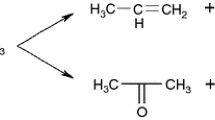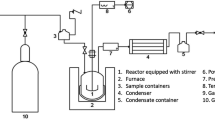Abstract
Efficient and sustainable cellulose conversion into chemicals requires the design of heterogeneous catalysts with controlled acid–base properties, mesoporosity and excellent stability in hydrothermal conditions. To this end, modified zirconia with anchored W, Mo, Ta and Nb oxoanions were prepared by ionic exchange using peroxo precursors of the selected transition metals. Modified zirconia samples were characterized by X-ray diffraction, N2 isotherms, FTIR of pyridine adsorption and microcalorimetry of ammonia adsorption. If the nature of the oxoanion tunes slightly the catalysts Lewis acid strength or density, it influences strongly their mesoporosity with mesopores in the range of 10 nm for ZrTa and ZrNb. Upon Pt loading, all the Pt-modified zirconia are effective to catalyze C–C and C-O cleavage during cellulose hydrogenolysis leading to PG as main short polyols with the co-formation of 2,5-hexanedione over ZrNb and ZrTa. Most important, ZrNb and ZrTa exhibit excellent water tolerance without any leaching nor structure modification. Combined to their mesoporosity, these features make ZrNb and ZrTa, true solid Lewis acids with high potential in the frame of bulky biomass conversion in hot waterier
Graphical Abstract









Similar content being viewed by others
References
Dhepe PL, Fukuoka A (2008) Cellulose conversion under heterogeneous catalysis. ChemSusChem 1(12):969–975
Ruppert AM, Weinberg K, Palkovits R (2012) Hydrogenolysis goes bio: from carbohydrates and sugar alcohols to platform chemicals. Angew Chem Int Ed 51(11):2564–2601
Cabiac A, Guillon E, Chambon F, Pinel C, Rataboul F, Essayem N (2011) Cellulose reactivity and glycosidic bond cleavage in aqueous phase by catalytic and non catalytic transformations. Appl Catal A General 402:1–10
Zheng M, Pang J, Sun R, Wang A, Zhang T (2017) Selectivity control for cellulose to diols: dancing on eggs. ACS Catal 7:1939–1954. https://doi.org/10.1021/acscatal.6b03469
Li N, Li Z, Wei L, Zheng Y, Shen Q, Shen Q, Ma Q, Tan M, Zhan M, Zhou J (2018) Effect of the surface acid sites of tungsten trioxide for highly selective hydrogenation of cellulose to ethylene glycol. Biores Technol 264:58–65
Li MQ, Ma YL, Ma XX, Sun YG, Song Z (2018) Insight into the efficient catalytic conversion of biomass to EG and 1,2-PG over W-Ni bimetallic catalyst. RSC Adv 8(20):10907–10913
Lv M, Xin Q, Yin D, Jia Z, Yu C, Wang T, Yu S, Liu S, Li L, Liu Y (2020) Magnetically recoverable bifunctional catalysts for the conversion of cellulose to 1,2-propylene glycol. ACS Sustain Chem Eng 8:3617–3625
Girard E, Delcroix D, Cabiac A (2016) Catalytic conversion of cellulose to C-2-C-3 glycols by dual association of a homogeneous metallic salt and a perovskite-supported platinum catalyst. Catal Sci Technol 6(14):5534–5542. https://doi.org/10.1039/c5cy01782c
Chambon F, Essayem N, Rataboul F, Pinel C, Cabiac A, Guillon E, (2012) Process for converting cellulose or lignocellulosic biomass using stable non-zeolite solid lewis acids based on tin or antimony alone or as a mixture, WO2012085361
Chambon F, Essayem N, Rataboul F, Pinel C, Cabiac A, Guillon E, (2012) Process for converting lignocellulosic or cellulose biomass via solid lewis acid catalysts based on tungsten oxide and on a metal chosen from groups 8 to 11, WO2012022853
Chambon F, Rataboul F, Pinel C, Cabiac A, Guillon E, Essayem N (2013) Cellulose conversion with tungstated-alumina-based catalysts: influence of the presence of platinum and mechanistic studies. ChemSusChem 6(3):500–507
Loridant S, Feche C, Essayem N, Figueras F (2005) WOx/ZrO2 catalysts prepared by anionic exchange: In situ Raman investigation from the precursor solutions to the calcined catalystsJ. Phys Chem B 109(12):5631–5637
Figueras F, Essayem N, Feche C, Loridant S, Palomeque J, Gelbard G (2004) Tungsten catalysts, WO 2004/004893
Essayem N, Russbueldt B, Fabiano DP, Eternot M, Hoelderich W (2019) New metallic catalysts, WO 2019081665
Kourieh R, Bennici S, Marzo M, Gervasini A, Auroux A (2012) Investigation of the WO3/ZrO2 surface acidic properties for the aqueous hydrolysis of cellobiose. Catal Comm 19:119–126
Pichat P (1966) PhD Thesis, Lyon1 University
Jollet V, Chambon F, Rataboul F, Cabiac A, Pinel C, Guillon E, Essayem N (2009) Non-catalyzed and Pt/gamma-Al2O3-catalyzed hydrothermal cellulose dissolution-conversion: influence of the reaction parameters and analysis of the unreacted cellulose. Green Chem 11(12):2052–2060
Chambon F, Rataboul F, Pinel C, Cabiac A, Guillon E, Essayem N (2015) Conversion of cellulose to 2,5-hexanedione using tungstated zirconia in hydrogen atmosphere. Appl Catal A: General 504:664–671
Chambon F, Rataboul F, Cabiac A, Pinel C, Guillon E, Essayem N (2011) Cellulose hydrothermal conversion promoted by heterogeneous Bronsted and Lewis acids: remarkable efficiency of solid Lewis acids to produce lactic acid. Appl Catal B Environ 105(1–2):171–181
Acknowledgements
The authors acknowledge the scientific services of IRCELYON for their contribution in this work.
Author information
Authors and Affiliations
Corresponding author
Additional information
Publisher's Note
Springer Nature remains neutral with regard to jurisdictional claims in published maps and institutional affiliations.
Rights and permissions
About this article
Cite this article
Dandach, A., Russbueldt, B., Toufaily, J. et al. Mesoporous Zirconium Oxide Prepared by Anchoring W, Mo, Nb, Ta Using Peroxo Precursors: Influence of the Oxoanions on the Pores Size and the Hydrothermal Catalysts Stability for Cellulose Conversion. Catal Lett 153, 1205–1214 (2023). https://doi.org/10.1007/s10562-022-04037-9
Received:
Accepted:
Published:
Issue Date:
DOI: https://doi.org/10.1007/s10562-022-04037-9




